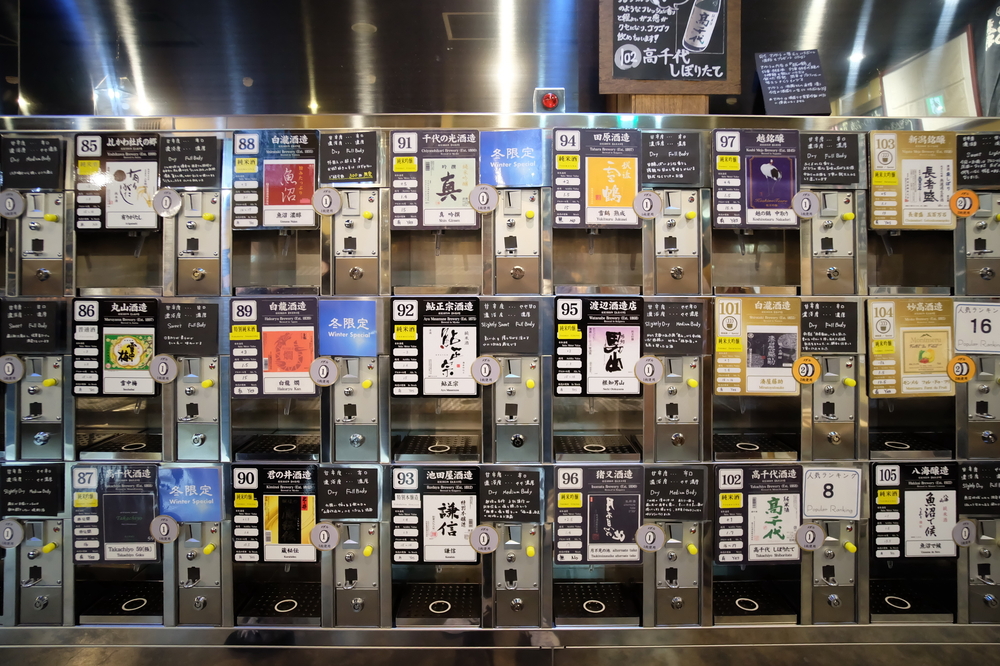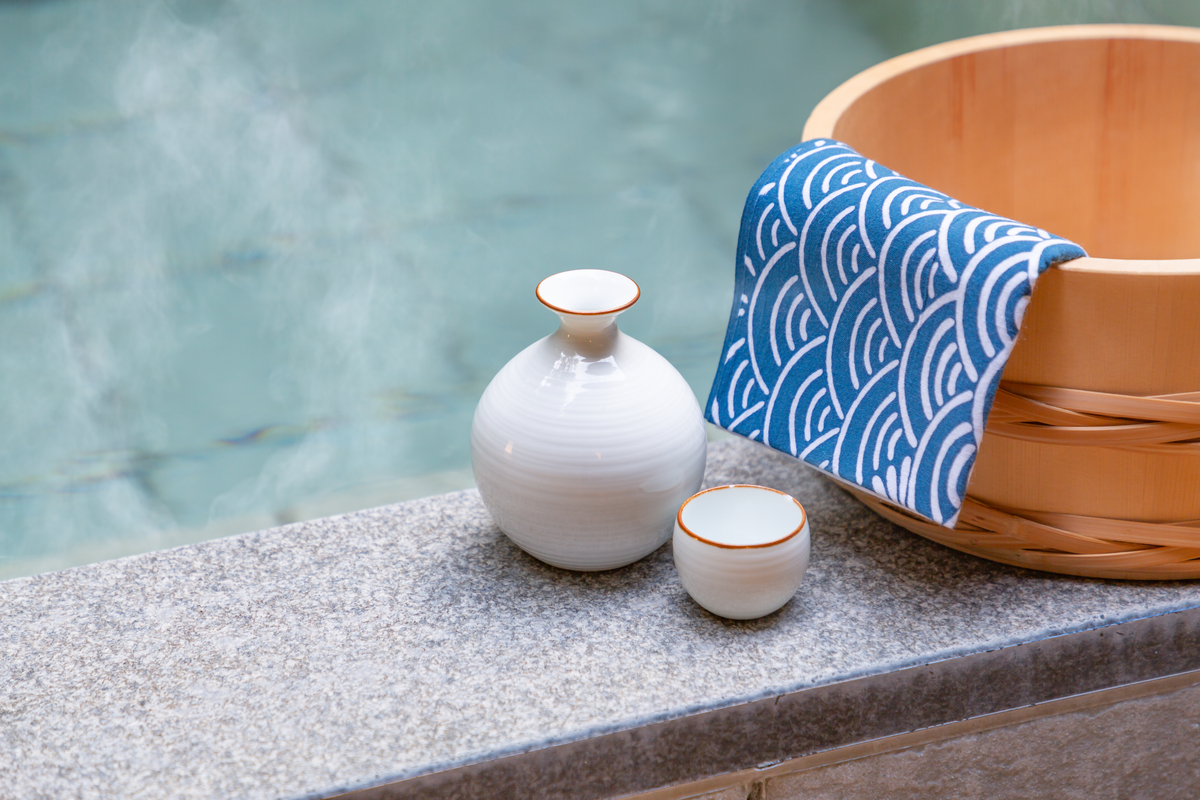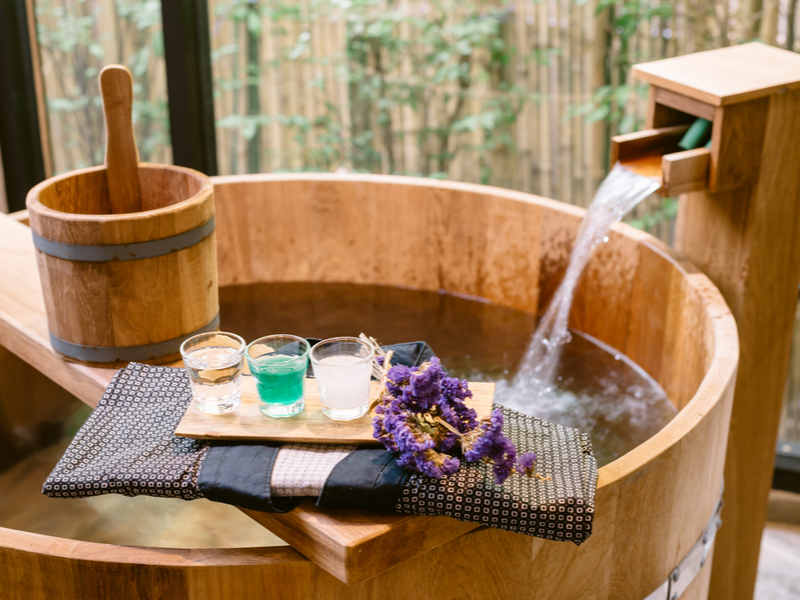Whether it’s adding matcha to chocolate or adding chocolate to a body scrub gel, flavor crossovers and combos are always exciting. We combine whiskey with KitKats, pour wine in stews and in Japanese cuisine we cook with sake. From sake flavor KitKats to bathing in sake — there are more ways to enjoy nihonshu than just drinking it. There is even a signature TW sake cocktail recipe you can try making.
Sake Vending Machines
While you might find the odd One Cup sake in the few remaining alcohol vending machines that are dotted around Tokyo, we’re talking about something different and altogether more impressive: Banks of vending machines dispensing sake from a variety of different breweries poured straight in the cup.
The closest place to Tokyo where you can experience this is at Showagura in Kawagoe, Saitama. Saitama has 35 sake breweries and at Showagura, some of their rarest tipples are on offer. ¥500 gets you four tokens. Stick them in the machine, place your choko cup in the correct spot, press the button and watch your drink flow down.

Further afield in Niigata Prefecture are the three Ponshukan Sake Museums. They can be found at Echigo-Yuzawa, Nagaoka and Niigata stations. Niigata Prefecture has around 90 sake breweries and you can drink sake from all of them out of vending machines at each venue. It has a similar system as Showagura, but here ¥500 gets you five tokens. Most sake is one token a cup, but there are some that cost two or three tokens. The locations of the Ponshukan Sake Museums make them perfect for skiers killing some time before getting on the Shinkansen. If you want to vicariously enjoy the experience, check this video out:
Sake Flavor Ice Cream
Are you a fan of boozy ice cream? You can make your own by simply pouring some sake directly on your vanilla ice cream. Depending on how much you add, you’ll create a vanilla liquor of sorts. Pick a sake with maltier characteristics – you’re more likely to find that in a sake with a higher rice-polishing ratio – as the umami of the sake goes well with the creamy texture of the ice cream.
Typically, sake flavor is added to ice cream using sake kasu. Sake kasu are sake lees created during the brewing process. Kasu are the solids (the waste) that are left when the rice is pressed to draw out the liquid we want during sake production. They are full of proteins, vitamins and amino acids. The addition of sake kasu to ice cream makes it lighter and more palate cleansing. Of course, there are many recipes on the internet you can use to make your own at home.
One company has decided to go one better. SAKEICE, opened in March 2020 in Asakusa, is Japan’s first high-alcohol concentration ice cream. By using actual sake during the ice cream-making process, they have done an outstanding job capturing the aroma and umami of sake. As a result, their ice cream has a deeper taste than conventional sake flavor ice cream. Coming in at four percent alcohol by volume, they have a number of variants made with sake brands such as Hakkaisan and Otokoyama.
View this post on Instagram
Sake Cosmetics
Sake has been used in beautification routines for centuries. Geisha traditionally used sake as a facial lotion before applying their makeup. In the 1970s scientists investigated why kurabito (sake brewery workers) had particularly smooth and supple hands, often despite their age. Contact with various parts of the brewing process had a positive effect on their skin. We understand the science a little more now. Sake containing amino acids, kojic acid, ferulic acid and other ingredients is perfect for cosmetic items. These bring with them hydration, smoothing, anti-aging, exfoliation and brightening benefits.
The origins of the SK-II cosmetic company are bound up in this research. A yeast extract called pitera was isolated and used in the brand’s products when they launched in the early 1980s. Today, there is a whole array of sake-infused creams, lotions, sheet masks, hair products and so on.
View this post on Instagram
Sake Bath
When we say you can bathe in sake, that is no exaggeration or artistic liberty. Similar to some of the benefits you would get from sake cosmetics, soaking in a sake bath raises your body temperature and stimulates perspiration, circulation and heart rate. This has a detoxifying effect on the body. As well as the ‘standard’ relief for aches and pains a bath provides, the amino acids in sake are useful for strengthening bones and helping muscles rebuild.
You can enjoy a sake bath in the comfort of your own home simply by adding sake to a hot bath. The amount you pour in is up to you. You can pour a cup or even an entire bottle. Different sake drinks have different aromas, so experiment and get some aromatherapy thrown in for free. To keep the whole endeavor wallet-conscious, there are plenty of great, cheaper sake that work very well in a sake bath.

Finally, you can go take a dip in a big sake bath someone else has drawn for you. At the Ponshukan in Echigo Yuzawa, CoCoLo Yuzawa offers a sake-infused hot spring that is safe for children. There’s also Hakone’s Yunessun Spa, which offers a sake bath, along with their wine and coffee baths.
There is a public bath that you can enjoy Sake Bath in Niigata🍶 pic.twitter.com/RIDJoyFMwG
— SAKETALK (@sake_talk) October 16, 2017
Sake Flavor KitKats
Japan is well known for being home to a number of unique KitKat flavors. Around 400 have been released since the brand’s first non-chocolate flavor (strawberry) was released back in 2000.
Nestle first released a sake flavor KitKat back in 2016, which contained 0.8 percent alcohol. Since then, they have escalated their sake game. Their next sake flavor release in autumn 2017 was launched with the backing of former Japanese football player Hidetoshi Nakata and Masuizumi, a Toyama-based sake brewery.
This was followed in 2018 by ume (plum) sake flavor, a collaboration with Wakayama-based Heiwa Shuzo brewery. A year later, there was a yuzu sake Kitkat. In 2020, a yogurt sake KitKat was released – this time using a sake made with Jersey yogurt made at Niizawa brewery in Miyagi Prefecture.
View this post on Instagram
There are a number of gotochi KitKats expressing regional flavors and the Kansai region’s specialty KitKat is sake flavored, given that Nada in Hyogo Prefecture is Japan’s top sake producing region. Sakura Masamune’s 11th-generation master brewer Tazaemon Yamamura jointly developed the bar with Nestle, using their daiginjo sake which is made with Yamada Nishiki rice grown in the prefecture. This sake is converted to powdered form, kneaded into the wafer filling, then covered in white chocolate.
We also had a 0.07 percent alcohol content sakura sake KitKat which had a limited release to coincide with the cherry blossom season.
View this post on Instagram
Sake Cocktails
Looked down on by some sake snobs, sake is actually increasingly finding a home in cocktails. Sake cocktails have become quite fashionable and have evolved well beyond the sake bomb, the infamous shot of sake dropped into a beer. World-famous bartenders from Japan and overseas are designing ambitious cocktails that showcase the drink’s versatility and range of flavors. And, as interest grows, these cocktails are appearing in more menus of high-end restaurants, luxury hotel bars and various other establishments around Tokyo.
Bonus: Sake Cocktail Recipe
The TW Saketini
Ingredients: sake, vodka or gin, ice, cucumber for garnish.
Half-fill a cocktail shaker with ice. Add 65ml of vodka or gin and 25ml of sake. Shake until ice cold. Strain into a chilled martini glass and garnish with cucumber. For a stronger drink with a citrus twist, add 25ml of Triple Sec or Cointreau and switch the garnish for some orange peel.

Kanpai!
Learn more about sake:
- Japanese Sake Tips That All Sake Lovers Should Know
- Japan’s Top 6 Regions for Local Sake
- All About Amazake: From the History of Fermentation to Modern Experimentation
- Learn Everything About Sake Through a Unique Podcast, Online Courses and Tokyo Tastings
Updated On July 8, 2021









